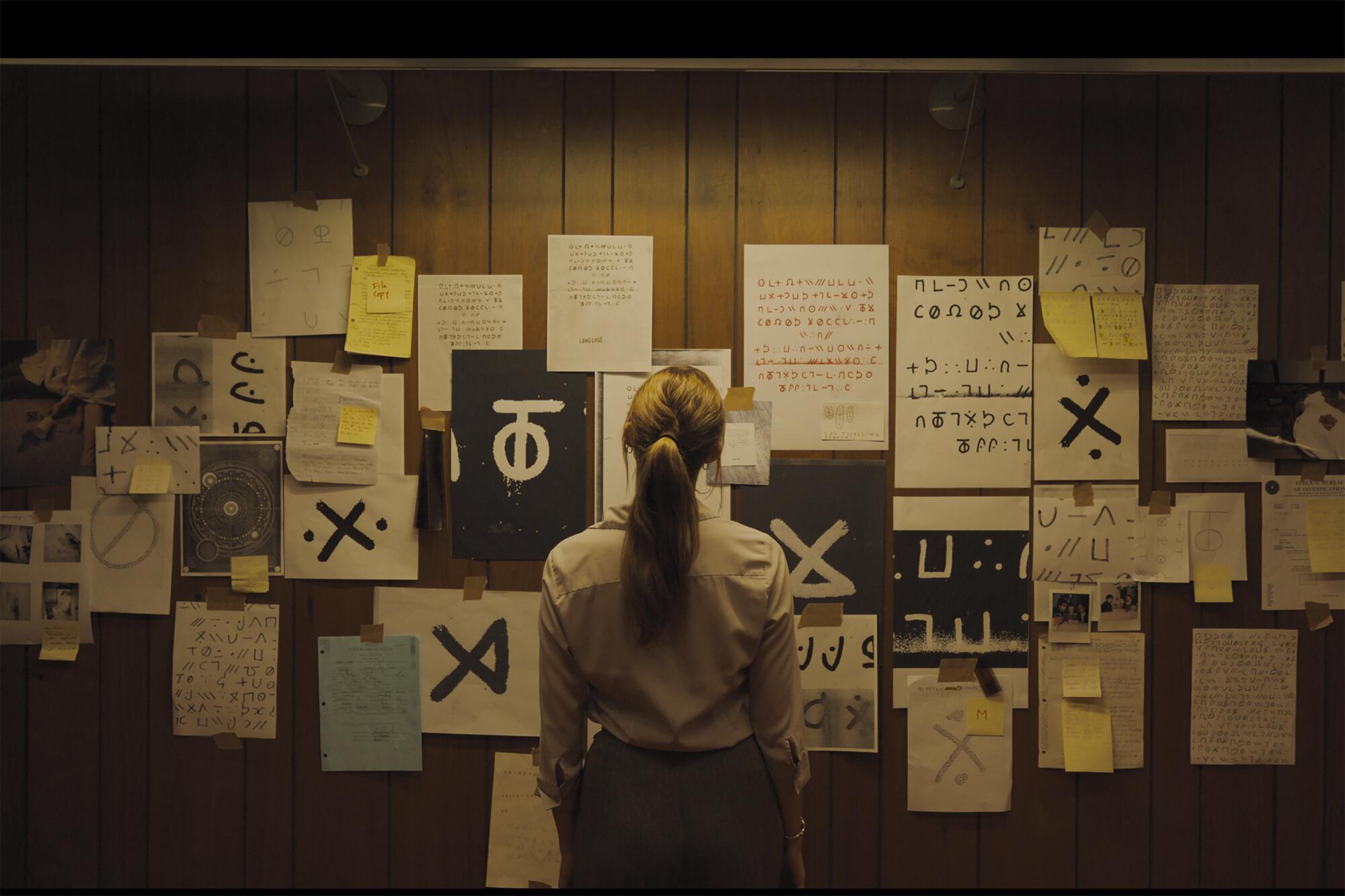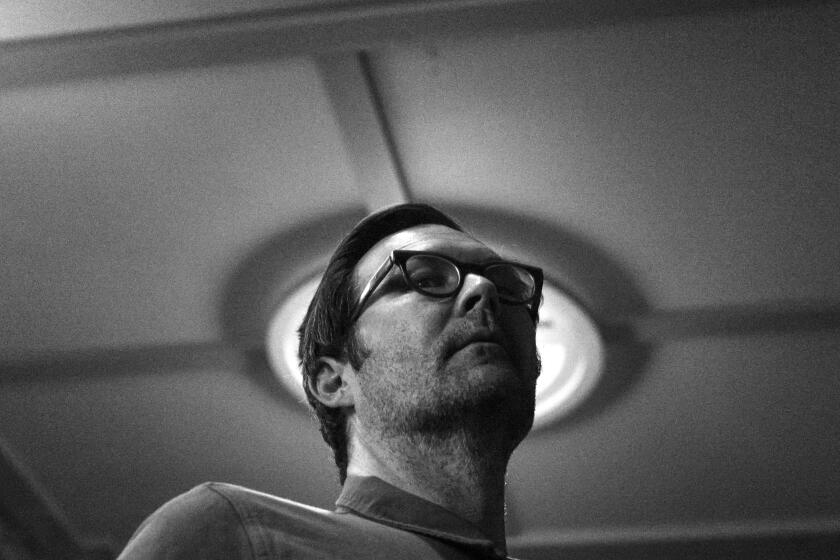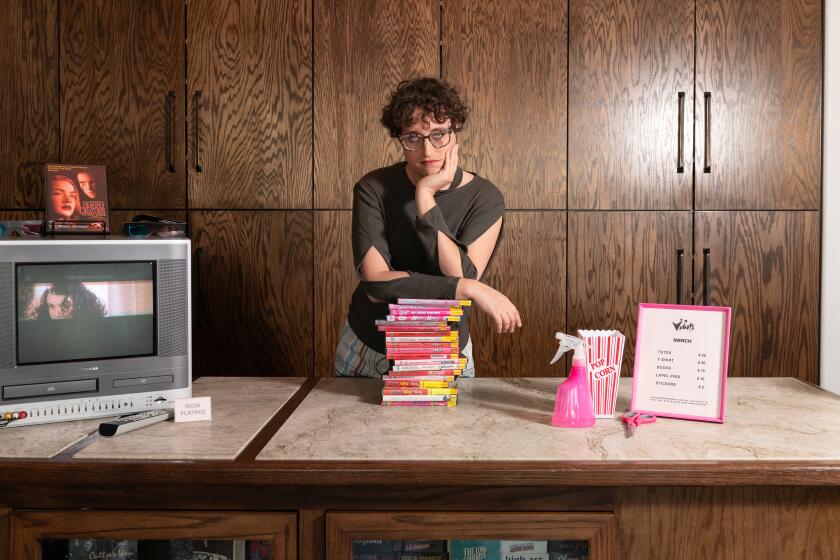- Share via

Horror movies took one step beyond elevated this year: Startling personal statements were made in the often-zomboid genre; self-image, culture and religion were given freshly dug-up perspectives; and conventions got turned on their ear or vivified with vibrant artistry.
“The year’s best horror movies are exciting because they don’t all have to be a Blumhouse-style jump scare or a franchise reboot that’s just a little more socially conscious than before,” says Jane Schoenbrun, whose singularly eerie “I Saw the TV Glow” links trans identity with dire nostalgia. “A lot of people are trying different, fun things.”
Writer-director Robert Eggers contends, “Horror right now is where filmmakers who have a unique voice and something to say are able to say it.” The filmmaker’s 2015 debut feature, “The Witch,” was a landmark in elevated horror, and his remake of the original arty vampire movie, “Nosferatu,” arrives at Christmas. “It’s one of the very few places where you can explore interesting ideas in commercial cinema at the moment.”
Here are six movies that advanced the genre in 2024:

‘Longlegs’
Osgood Perkins wrote and directed this waking nightmare about Maika Monroe’s psychic FBI agent on the trail of ... if not quite a serial killer, the looniest murder influencer ever. Nicolas Cage’s title superfreak channels 1930s horror villain Dwight Frye, “The Silence of the Lambs” baddie Buffalo Bill and a smidge of the filmmaker’s father, Anthony Perkins, who starred in the mother of all genre-changers, “Psycho.”
“‘Longlegs’ has got dolls, the devil, nuns, serial killers, FBI, demons, voices, ax murderers ...,” Perkins points out. “It was meant to press all of the buttons that bring horror audiences joy. I didn’t think it was the scariest movie of the decade or whatever earlier notices framed it as. It was much more of a Pop art piece that I just wanted people to really groove on. I got lucky that my taste coincided with the need for some originality in art and culture.”
He has a famous father, “Psycho” icon Anthony Perkins. But the director of “Longlegs,” a brooding serial killer film, has a sensibility that’s all his own.

‘Heretic’
In a great year for religious horror — “Immaculate” and ”The First Omen” expanded the nunsploitation subgenre — “Heretic” turned probing discourse into existential menace. Co-directors Scott Beck and Bryan Woods, who wrote “A Quiet Place,” went the other way with this story of a voluble Hugh Grant challenging, then terrorizing, Chloe East and Sophie Thatcher’s young Mormon missionaries.
“It’s an adult conversation about religion and faith in the context of the horror genre; we felt like we hadn’t seen that before,” says Woods. “The thrill of ‘A Quiet Place’ was how can we tell a scary, emotionally resonant story without any dialogue whatsoever. This one was how can we only use dialogue to provoke, terrify and generate suspense.”
That required virtuoso acting versatility.
“The ebb and flow was so important,” Beck notes. “It’s one of the reasons Hugh Grant was such an exciting idea. Everybody knows Hugh from romantic comedies; he feels safe, familiar and charming. He has that capacity in this movie, but it also goes to his deeper, darker register that plays the audience like a piano.”
Sophie Thatcher, Chloe East and a perversely charming Hugh Grant commit to a deftly acted, somewhat predictable horror movie set in a remote house with secrets.

‘Strange Darling’
“Crash” and “Yellowstone” producer Bob Yari chose JT Mollner’s “Strange Darling” — a cannily time-shuffled reworking of “final girl” slasher tropes — to launch his indie film distribution company, Magenta Light. It’s his first investment in the horror genre.
“This absolutely takes a step away from your standard horror/thriller film and pulls a ‘Pulp Fiction,’” Yari enthuses. “It’s extremely clever in its construct. You watch it in this out-of-order fashion, yet your brain somehow assembles it in linear form. It’s a fun but really artistic ride with powerful twists and surprises.”
And a scream queen like no other is born in Willa Fitzgerald’s unnamed protagonist.
“There’s an element of female empowerment in that, ‘Hey, we can be just as bad as guys,’” Yari observes. “I know that’s kind of a weird take on it, but I’ve actually heard women say they thought that was a cool part.”

‘The Substance’
Body horror explodes oppressive female beauty standards in “The Substance.” Demi Moore’s aging TV exercise host takes the mysterious title compound and a younger, fitter, hotter version (Margaret Qualley) emerges to renewed media success — until the Substance is abused with monstrous results.
“We’re asked to be nice and delicate, thin, smiling,” says Coralie Fargeat, the film’s French writer-director. “I wanted the character, at the end of the movie, to be the total opposite: loud, gross, violent, excessive. When she’s past the normal human appearance, the character can finally see herself for who she is and not care anymore about what she looks like.
“I don’t write a lot of dialogue, so my movies seek the strongest symbols for the story I want to tell,” Fargeat adds. “I love the grammar of powerful images because they stay with you. That’s what drives me to horror, where there is this simplicity of symbol usage to say stronger things underneath.”
In the Monday edition of his newsletter, Times columnist Glenn Whipp spends time with Demi Moore and loves the choice of Conan O’Brien as host of the 97th Oscars.

‘I Saw the TV Glow’
Schoenbrun found a connection between an interest in all things horror and subsequent gender affirmation.
“I grew up so in love with horror and spooky nocturnal things, and only later on, as I came out to myself as queer and transgender, I realized there was a relationship between that and other things that people found grotesque,” they reveal. “The movie is trying to articulate and reflect on this, not so much trying to scare you as express coming into self and queerness.”
The goofy supernatural show the film’s ’90s teens are obsessed with doesn’t conclude satisfactorily. That provides a cautionary metaphor for investing too much in the pop culture past.
“I loved the idea of the ghost of that VHS tape that you might have this vague memory of becoming a symbol of your inability to become yourself, grow up or resolve your own cliffhanger in life,” Schoenbrun says.
Loaded with teenage confusion and intense fandom, ‘I Saw the TV Glow’ speaks to its audience in an intimate way. Its trans director made the film as a lifeline.

‘Nosferatu’
Every frame is, well, worth framing in Eggers’ richly mounted remake of F.W. Murnau’s 1922 Expressionist masterpiece. Bill Skarsgård’s Count Orlok is more a Romanian folk vampire — decayed but still quite libidinous — than suave, past aristocrats limned by Bela Lugosi and Christopher Lee.
“I have joked — and it’s not a bad comp — that we’re reaching for Merchant/Ivory doing Hammer Horror,” says Eggers, who staged a version of the Germanic “Dracula” doppelgänger in high school.
He filmed the new “Nosferatu” inside studios and outside castles in Eastern Europe, striving for authenticity in everything from 1830s peasant garb to retrograde psychological beliefs. But it’s all the little things that add up to true creepy art.
“There were more challenging sequences, but I’m very pleased by our cemetery funeral,” Eggers points out. “It has a very dialed-in version of traditional Gothic atmosphere with the fog machine and leafless trees, the design of the grave markers and mausoleum, and the Victorian mourning attire. It’s a very satisfying version of that kind of scene.”
More to Read
From the Oscars to the Emmys.
Get the Envelope newsletter for exclusive awards season coverage, behind-the-scenes stories from the Envelope podcast and columnist Glenn Whipp’s must-read analysis.
You may occasionally receive promotional content from the Los Angeles Times.














